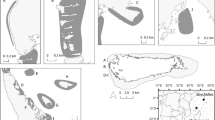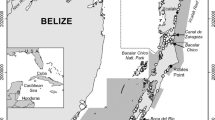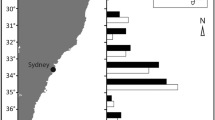Abstract
Recaptures of white seabass Atractoscion nobilis from a marine stock enhancement program were analyzed to understand long-term movement patterns within the Southern California Bight, USA. Between 1999 and 2020, white seabass at liberty for 1–20 years were recaptured as legal-sized (≥ 711 mm TL) adults recruited to California commercial and recreational fisheries. Movement metrics were quantified for 190 recaptures that had been released as juveniles (91–466 mm TL) from a large offshore island, Santa Catalina Island, or from coastal areas. Santa Catalina Island-released white seabass tended to be recaptured in the vicinity of the island up to 7 years post-release (minimum displacement distance = 18.0 ± 4.9 km (mean ± SE)). In contrast, white seabass released from coastal areas were at liberty for up to 20 years and moved significantly farther (145.0 ± 9.2 km and 82.9 ± 5.5 km for southern and northern coastal release areas, respectively), to areas of habitat continuous to (i.e., elsewhere along the coast) and disconnected from (i.e., islands and other offshore areas) the point of release. Minimum displacement distance distributions for 2-year time at liberty intervals (and fitted Weibull curves) further demonstrated the heterogeneous movement patterns associated with Santa Catalina Island and coastal release areas. White seabass released from coastal areas were predominantly recaptured in a west to north west direction from the point of release. Divergent movement metrics were not detected between male and female white seabass. This study provides much needed information on the long-term movement and dispersal of hatchery-reared white seabass, which will help guide stock enhancement management strategies of this highly mobile marine fish species.





Similar content being viewed by others
Availability of data and material
Requests should be addressed to the corresponding author.
Code availability
Not applicable.
References
Aalbers SA, Drawbridge MA (2008) White seabass spawning behavior and sound production. Trans Am Fish Soc 137:542–550
Aalbers SA, Sepulveda CA (2015) Seasonal movement patterns and temperature profiles of adult white seabass (Atractoscion nobilis) off California. Fish Bull 113:1–14
Aalbers SA, Sosa-Nishizaki O, Stopa JE, Sepulveda CA (2021) Movement patterns of white seabass Atractoscion nobilis tagged along the coast of Baja California, Mexico. Environ Biol Fish https://doi.org/10.1007/s10641-021-01091-x
Bowlby HD, Hanson JM, Hutchings JA (2007) Resident and dispersal behavior among individuals within a population of American lobster Homarus americanus. Mar Ecol Prog Ser 331:207–218
Björnsson B, Karlsson H, Thorsteinsson V, Solmundsson J (2011) Should all fish in mark–recapture experiments be double-tagged? Lessons learned from tagging coastal cod (Gadus morhua). ICES J Mar Sci 68:603–610
Breen P, Posen P, Righton D (2015) Temperate Marine Protected Areas and highly mobile fish: A review. Ocean Coast Manag 105:75–83
California Sea Grant (2017) Evaluation of the Ocean Resources Enhancement and Hatchery Program. Report submitted to California Department of Fish and Wildlife, Project no. P1470005. 12 December 2017. Publication no. CASG-17–010. https://nrm.dfg.ca.gov/FileHandler.ashx?DocumentID=154110&inline Accessed 5 May 2021
Clevenstine AJ, Lowe CG (2021) Aggregation site fidelity and movement patterns of the protected marine predator giant sea bass (Stereolepis gigas). Environ Biol Fish 104:401–417
Delignette-Muller ML, Dutang C (2015) fitdistrplus: An R package for fitting distributions. J Stat Softw 64:1–34
Denson MR, Brenkert K IV, Jenkins WE, Darden TL (2012) Assessing red drum juvenile stocking in a South Carolina estuary using genetic identification. N Am J Fish Manag 32:32–43
den Heyer CE, Chadwick EMP, Hutchings JA (2009) Diffusion of American lobster (Homarus americanus) in Northumberland Strait, Canada. Can J Fish Aquat Sci 66:659–671
Dick EJ, He X (2019) Status of Cowcod (Sebastes levis) in 2019. Pacific Fishery Management Council, Portland, OR. http://www.pcouncil.org/groundfish/stock-assessments/ Accessed 10 August 2021
Drawbridge M, Shane M, Silbernagel C (2021) The status of white seabass, Atractoscion nobilis as a commercially ready species for marine US aquaculture. J World Aquac Soc 52:647–661
Fairchild EA, Rennels N, Howell WH (2009) Using telemetry to monitor movements and habitat use of cultured and wild juvenile winter flounder in a shallow estuary. In: Nielsen JL, Arrizabalaga H, Fragoso N, Hobday A, Lutcavage M, Sibert J (eds) Tagging and tracking of marine animals with electronic devices. Reviews: methods and technologies in fish biology and fisheries, vol. 9. Springer, Heidelberg, Germany pp. 5–22
Gillanders BM, Ferrell DJ, Andrew NL (2001) Estimates of movement and life-history parameters of yellowtail kingfish (Seriola lalandi): how useful are data from a cooperative tagging programme? Mar Freshw Res 52:179–192
Hammer Ø, Harper DAT, Ryan PD (2001) PAST: Paleontological statistics software package for education and data analysis. Palaeontol Electron 4:1–9
Hervas S, Lorenzen K, Shane MA, Drawbridge MA (2010) Quantitative assessment of a white seabass (Atractoscion nobilis) stock enhancement program in California: Post-release dispersal, growth and survival. Fish Res 105:237–243
Horn MH, Allen LG (1978) A distributional analysis of California coastal marine fishes. J Biogeogr 5:23–42
Leber KM (2004) Marine stock enhancement in the USA: status, trends and needs. In: Leber KM, Kitada S, Blankenship HL, Svåsand T (eds) Stock enhancement and sea ranching: developments, pitfalls and opportunities, 2nd edn. Blackwell Publishing Ltd, Oxford, UK, pp 11–24
Lino PG, Bentes L, Abecasis D, dos Santos MN & Erzini K (2009) Comparative behavior of wild and hatchery reared white sea bream (Diplodus sargus) released on artificial reefs off the Algarve (Southern Portugal). In: Nielsen JL, Arrizabalaga H, Fragoso N, Hobday A, Lutcavage M, Sibert J (eds) Tagging and tracking of marine animals with electronic devices. Reviews: methods and technologies in fish biology and fisheries, vol. 9. Springer, Heidelberg, Germany pp. 23–34
Lorenzen K, Leber KM, Blankenship HL (2010) Responsible approach to marine stock enhancement: an update. Rev Fish Sci 18:189–210
Kent DB, Drawbridge MA, Ford RF (1995) Accomplishments and roadblocks of a marine stock enhancement program for white seabass in California. Am Fish Soc Symp 15:492–498
Pittman SJ, McAlpine CA (2003) Movements of marine fish and decapod crustaceans: process, theory and application. In: Southward AJ, Tyler PA, Fuiman LA, Young CM (eds) Advances in marine biology, vol 44. Academic Press. Elsevier, London, UK, pp 205–294
R Core Team (2019). R: A language and environment for statistical computing. R Foundation for Statistical Computing, Vienna, Austria. https://www.R-project.org/
Rudd NT, McEvoy PB (1996) Local dispersal by the cinnabar moth Tyria jacobaeae. Ecol Appl 6:285–297
Silbernagel C, Shane M, Drawbridge M (2021) Quality considerations and malformation surveillance in a marine stocking program. Bull Mar Sci. https://doi.org/10.5343/bms.2020.0038
Simon J, Wickström H. (2020) Long-term retention of alizarin red S marks and coded wire tags in European eels. Fish Res 224:105453
Sparrevohn CR, Nielsen A, Støttrup JG (2002) Diffusion of fish from a single release point. Can J Fish Aquat Sci 59:844–853
Turchin P (1998) Quantitative analysis of movement: measuring and modeling population redistribution in animals and plants. Sinauer, Sunderland, MA
Vojkovich M, Crooke S (2001) White seabass. In Leet WS, Dewees CM, Klingbeil R, Larson EJ (eds). California’s living marine resources: a status report. California Department of Fish and Game, Sacramento CA pp. 206–208
Zimmermann EW, Purchase CF, Fleming IA, Brattey J (2013) Dispersal of wild and escapee farmed Atlantic cod (Gadus morhua) in Newfoundland. Can J Fish Aquat Sci 70:747–755
Acknowledgements
Thanks to the numerous HSWRI staff, San Diego State University staff and students, and volunteers who have assisted over the course of 30+ years with the white seabass release and recapture efforts described in this study. We would also like to acknowledge the cooperation of the southern California recreational and commercial fishing communities and California Department of Fish and Wildlife in facilitating the recovery of tagged white seabass. The constructive comments provided by anonymous reviewers greatly improved an earlier draft.
Funding
This work was supported by the Ocean Resources Enhancement and Hatchery Program.
Author information
Authors and Affiliations
Corresponding author
Ethics declarations
Ethics approval
The work described here has been approved by the Institutional Animal Care and Use Committee at Hubbs-SeaWorld Research Institute.
Consent to participate
Not applicable.
Consent for publication
All authors consent to publication of this manuscript.
Conflict of interest
The authors declare no competing interests.
Additional information
Publisher’s note
Springer Nature remains neutral with regard to jurisdictional claims in published maps and institutional affiliations.
Rights and permissions
About this article
Cite this article
MacNamara, R., Shane, M. & Drawbridge, M. Understanding the long-term movement patterns of hatchery-reared white seabass. Environ Biol Fish 105, 1797–1808 (2022). https://doi.org/10.1007/s10641-021-01183-8
Received:
Accepted:
Published:
Issue Date:
DOI: https://doi.org/10.1007/s10641-021-01183-8




